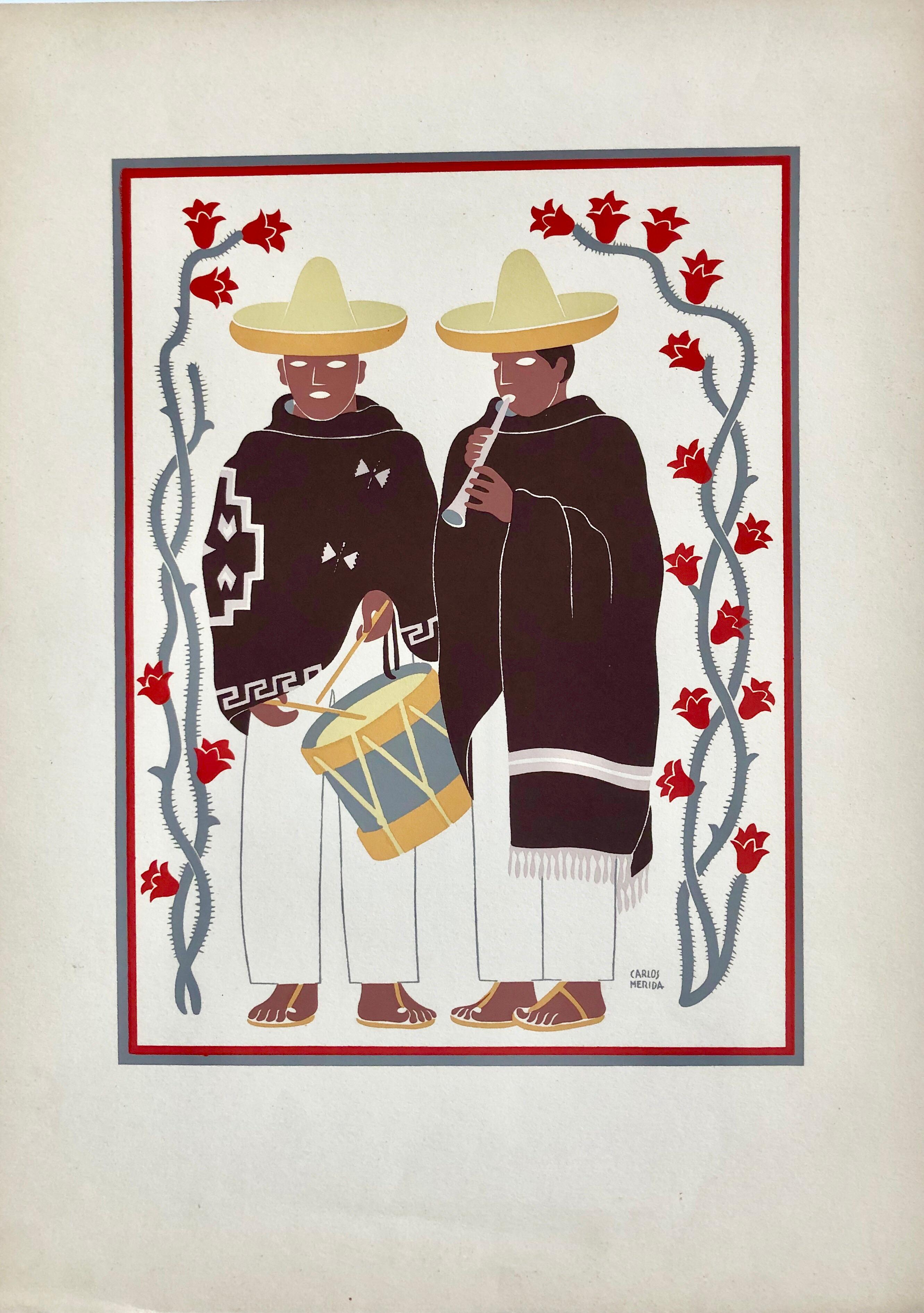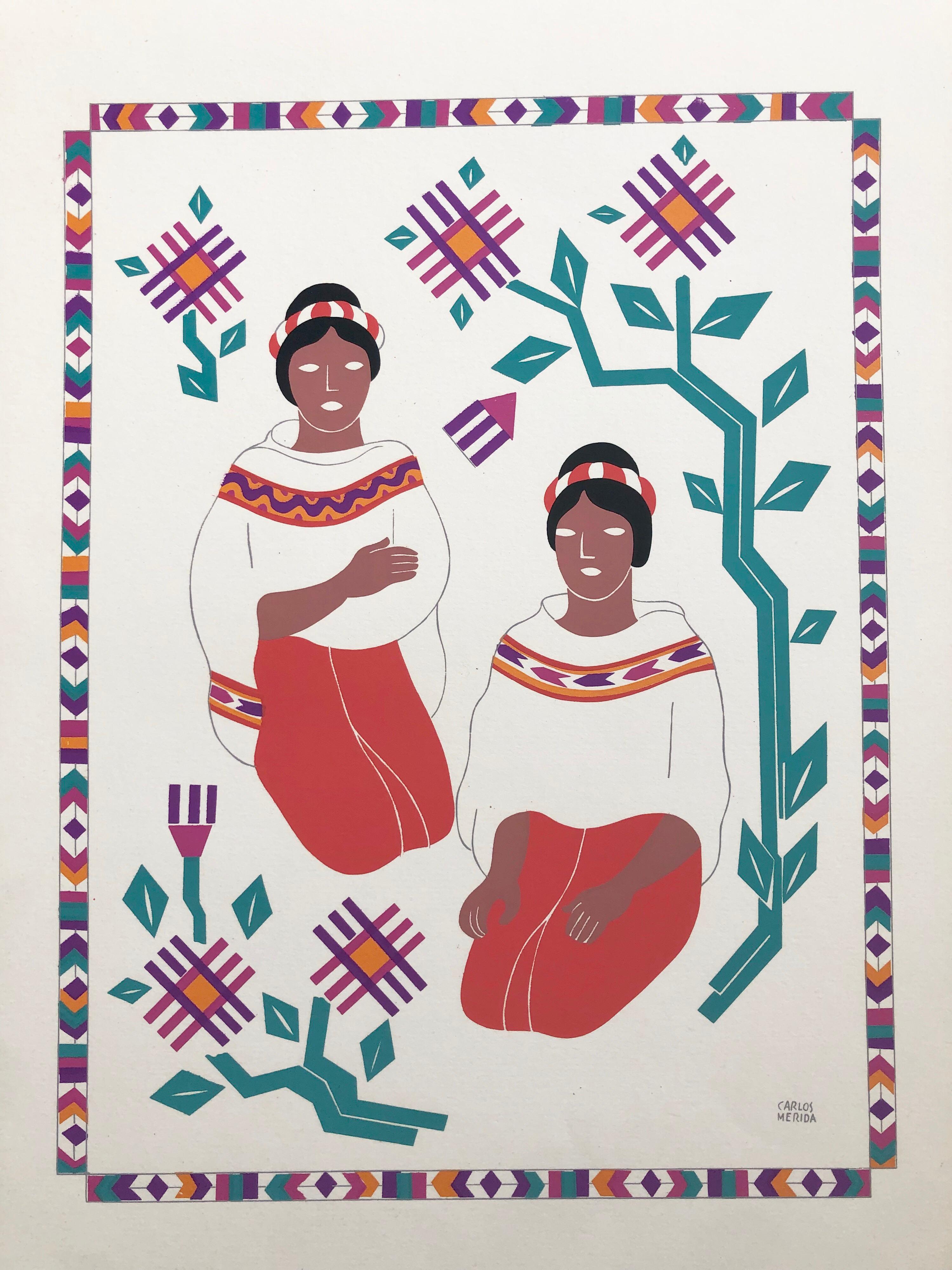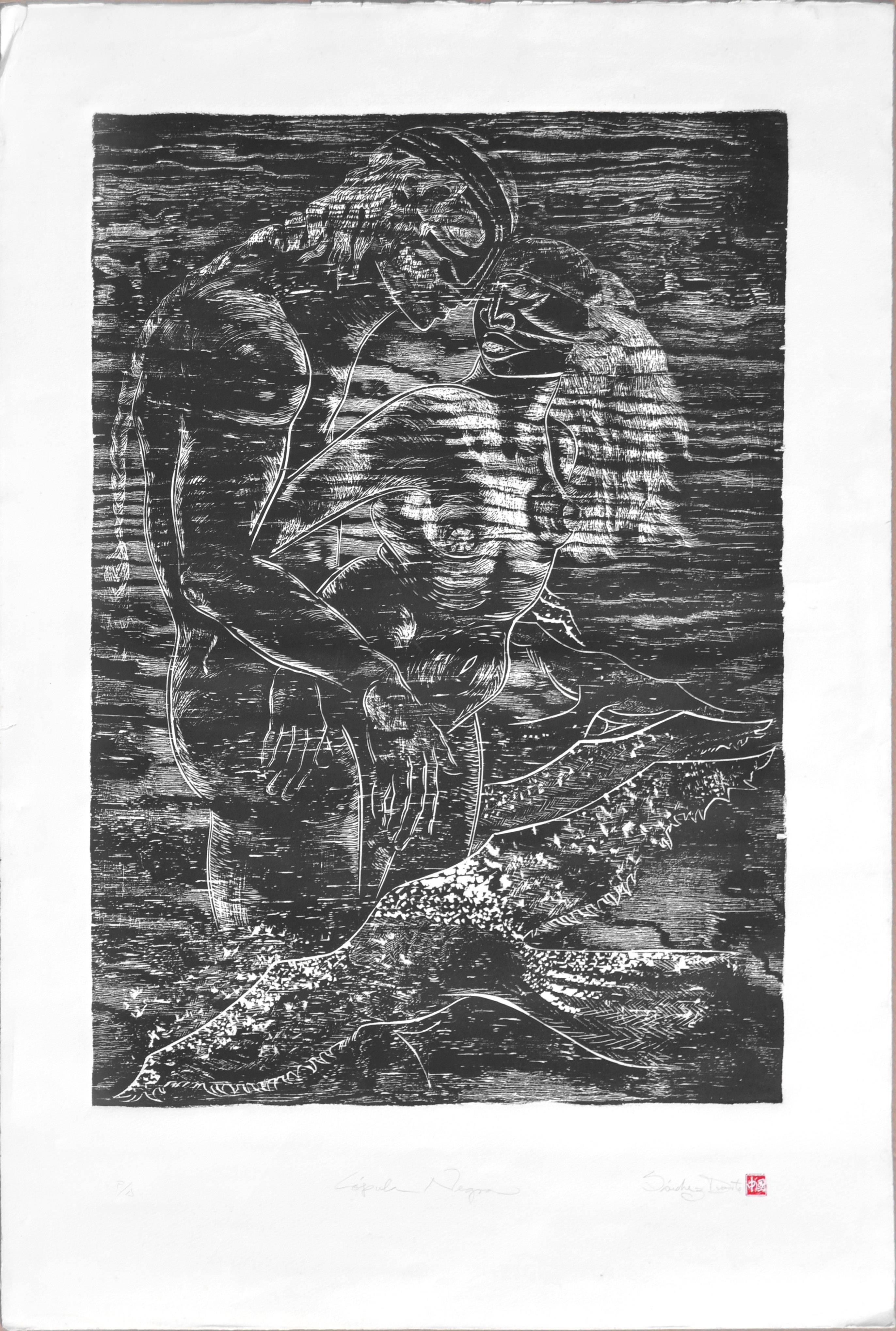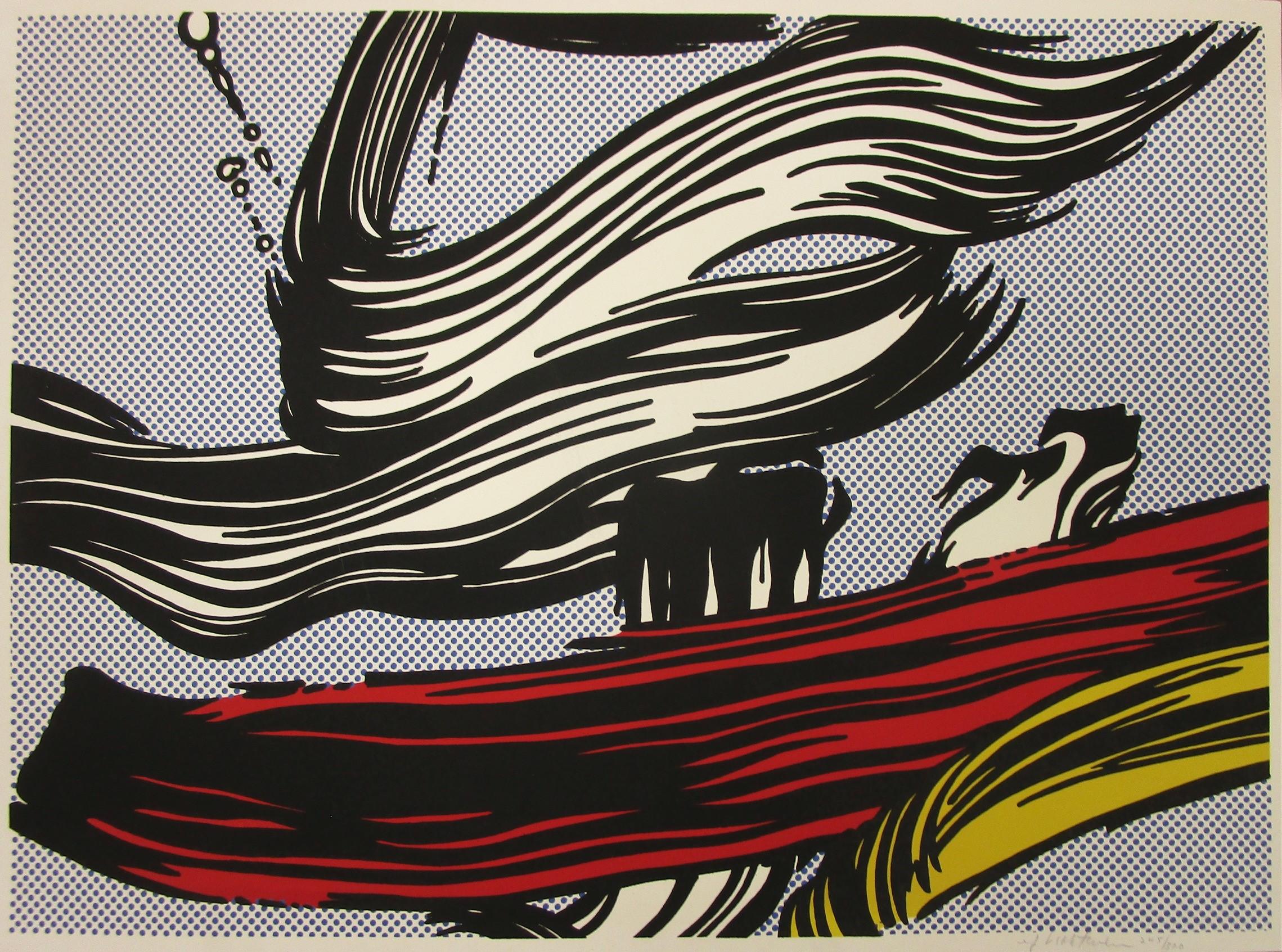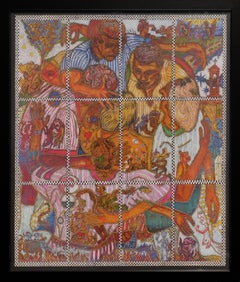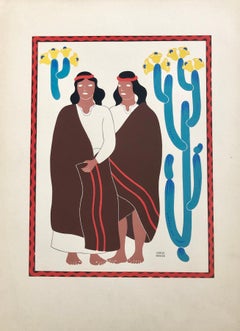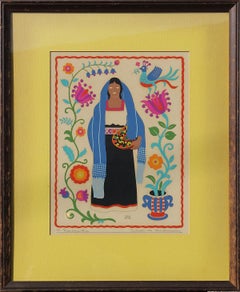
Plate 11: a Purépecha (or Tarascan) Woman from the State of Michoacán Silkscreen
View Similar Items
Want more images or videos?
Request additional images or videos from the seller
1 of 17
Carlos MéridaPlate 11: a Purépecha (or Tarascan) Woman from the State of Michoacán Silkscreen1945
1945
About the Item
- Creator:Carlos Mérida (1895-1984, Guatemalan)
- Creation Year:1945
- Dimensions:Height: 20.75 in (52.71 cm)Width: 17.06 in (43.34 cm)Depth: 0.75 in (1.91 cm)
- Medium:
- Movement & Style:
- Period:
- Condition:Wear consistent with age.
- Gallery Location:Houston, TX
- Reference Number:Seller: A2021.1130.32991stDibs: LU55139248582

About the Seller
5.0
Vetted Seller
These experienced sellers undergo a comprehensive evaluation by our team of in-house experts.
Established in 1969
1stDibs seller since 2014
783 sales on 1stDibs
Typical response time: 9 hours
More From This SellerView All
- "Languor of Love" Contemporary Figurative Screen Print Edition 268 of 295By Mark KostabiLocated in Houston, TXPop art style figurative screenprint with two sets of figures in an embrace on cube shapes. In the middle is a lone figure with their head resting on their hand. The screenprint is a...Category
1990s Contemporary Figurative Prints
MaterialsScreen
- The Magic of Teotitlan Edition 5/100Located in Houston, TXBeautiful black and white lithograph with a bold pop of color with a Mexican blanket titled "The Magic of Teotitlan" by artist Janis Schwartz-Stegall....Category
21st Century and Contemporary Contemporary Figurative Prints
MaterialsLithograph
- “The Final Compromise” Figurative Mosaic-Style Laser Inkjet Print Ed 1/10By Richard FluhrLocated in Houston, TXWarm toned mosaic style figurative abstract by Texas based artist Richard E. Fluhr. The work features a group of abstract figures broken up into a grid of twelve rectangles set against a black and white checkered background. Signed, dated, and editioned by the artist in the front lower left corner. Currently hung in a solid black frame. Dimensions Without Frame: H 41 in. x W 35 in. Artist Biography: Richard E. Fluhr was born in New York City in 1955 and moved to Texas to work as an artist. Beginning with ceramics at age 15 and showing at Ola Podrida Gallery in Dallas, he moved on to the University of Texas at Austin. Fluhr received his BFA from the University of Houston followed by an MFA in printmaking at the prestigious Cranbrook Academy of Art in Bloomfield Hills, Michigan, where he graduated magna cum laude. He traveled extensively, painting life along the way in watercolor, oil or acrylic, usually on recycled materials, such as paper bags, pamphlets, and receipts. Fluhr exhibited in six galleries in the United States and several galleries in Mexico, where he also maintained a studio in the late 1980s. His art has been shown in the U.S., Russia, and Mexico and is represented in over 900 private and public collections, including the Brooklyn Museum of Art, NY; the Cranbrook Academy of Art Museum, Bloomfield Hills, MI; the Detroit Art...Category
1990s Abstract Abstract Prints
MaterialsArchival Paper, Laser
- "El Espejo" Teal, Brown and Blue Toned Modernist Figurative PrintLocated in Houston, TXTeal, brown and blue tone abstract figurative original print by Amado Maurilio Pena. The piece depicts five women figures that either appear back-to-back or fa...Category
1970s Modern Abstract Prints
MaterialsArchival Pigment
- “Bonito Sueño” Monochromatic Abstract Figurative LithographLocated in Houston, TXMonochromatic abstract figurative lithography by Fermin Coronado. The piece depicts a figure of a lady surrounded by botanical elements. The piece is signed at the bottom. Framed in a simple gold frame...Category
20th Century Abstract Figurative Prints
MaterialsLithograph
- Black and White Etching of AngelsLocated in Houston, TXMonochromatic abstract figurative lithograph of the Seven Archangels. Framed and matted in a beautiful ornate gold frame. Unsigned. Dimensions With Frame: H 6.13 in. x W 8 in.Category
Early 20th Century Abstract Figurative Prints
MaterialsLithograph
You May Also Like
- 1945 Mexican Modernist Silkscreen Serigraph Print Regional Folk Art Dress MexicoLocated in Surfside, FLThis listing is for the one Silkscreen serigraph piece listed here. Mexico City, 1945. First edition. plate signed, limited edition of 1000, these serigraph plates depict various types of traditional and folk art indigenous clothing and costume styles from around Mexico. The illustrations depict the cultures of many different states in Mexico, including Oaxaca, Chiapas, Jalisco and Veracruz. Carlos Mérida (December 2, 1891 – December 21, 1985) was a Guatemalan artist who was one of the first to fuse European modern painting to Latin American themes, especially those related to Guatemala and Mexico. He was part of the Mexican muralism movement in subject matter but less so in style, favoring a non-figurative and later geometric style rather than a figurative, narrative style. Mérida is best known for canvas and mural work, the latter including elements such as glass and ceramic mosaic on major constructions in the 1950s and 1960s. One of his major works, on the Benito Juarez housing complex, was completely destroyed with the 1985 Mexico City earthquake, but a monument to it exists at another complex in the south of the city. Carlos Mérida was born Carlos Santiago Ortega in Guatemala City to Serapio Santiago Mérida and Guadalupe Ortega Barnoya. He later changed his name what is known by as he thought it was more sonorous. His brothers and children also took the Mérida name later on. He was of mixed Spanish/Maya-Quiché heritage which he promoted during his life. As a young child, Mérida had both music and art lessons, and his first passion was music, which led to piano lessons. He studied at a trade school called the Instituto de Artes y Oficios, then the Instituto de Ciencias y Letras. Here he began to have a reputation for the avant garde. Merída’s first trip to the United States was in 1917, where he met writer Juan José Tablada. Mérida made several trips to Europe over his lifetime to both study art and work as an artist and diplomat. His early trips in the 1920s and 1930s put him in touch with both avant garde movements in Europe as well as noted Latin American artists, especially those from Mexico. His last trip was in 1950s. In 1963, he donated canvases, graphic pieces and mural sketches to the Universidad Nacional Autónoma de Mexico. Merida was one of a number of artists such as Diego Rivera and Gerardo Murillo who became committed to promoting the handcrafts and folk art of Mexico and Central America, with a particular interest in those of Guatemala, often featuring Mayan textiles or elements in their decoration in his artwork. He died in Mexico City at the age of 94 on December 21, 1985. As there was little opportunity for artists in Guatemala, in 1910, Mérida traveled to Paris with a friend named Carlos Valenti on a German cargo ship. From then until 1914, he lived and worked in Paris and traveled much of Europe. This put him in touch with European avant garde artists such as Van Dagen, Amedeo Modigliani, Pablo Picasso and Piet Mondrian as well as Latin American artists studying in Europe such as Diego Rivera, Jorge Enciso, Ángel Zárraga and Dr. Atl. He exhibited his work in venues such as the Independent Salon and the Giroux Gallery in Paris. Mérida has forty five exhibitions in the United States and eighteen in Mexico from 1928 to 1948. These included an exhibition with Rufino Tamayo at the Art Center of New York (1930), the John Becker and Valentine galleries in New York (1930), the Club de Escritores de México and the Galería Posada in Mexico City (1931), the Stendhal Gallery and the Stanley Rose...Category
1940s Folk Art Figurative Prints
MaterialsScreen
- 1945 Mexican Modernist Silkscreen Serigraph Print Regional Folk Art Dress MexicoLocated in Surfside, FLThis listing is for the one Silkscreen serigraph piece listed here. Mexico City, 1945. First edition. plate signed, limited edition of 1000, these serigraph plates depict various types of traditional and folk art indigenous clothing and costume styles from around Mexico. The illustrations depict the cultures of many different states in Mexico, including Oaxaca, Chiapas, Jalisco and Veracruz. Carlos Mérida (December 2, 1891 – December 21, 1985) was a Guatemalan artist who was one of the first to fuse European modern painting to Latin American themes, especially those related to Guatemala and Mexico. He was part of the Mexican muralism movement in subject matter but less so in style, favoring a non-figurative and later geometric style rather than a figurative, narrative style. Mérida is best known for canvas and mural work, the latter including elements such as glass and ceramic mosaic on major constructions in the 1950s and 1960s. One of his major works, on the Benito Juarez housing complex, was completely destroyed with the 1985 Mexico City earthquake, but a monument to it exists at another complex in the south of the city. Carlos Mérida was born Carlos Santiago Ortega in Guatemala City to Serapio Santiago Mérida and Guadalupe Ortega Barnoya. He later changed his name what is known by as he thought it was more sonorous. His brothers and children also took the Mérida name later on. He was of mixed Spanish/Maya-Quiché heritage which he promoted during his life. As a young child, Mérida had both music and art lessons, and his first passion was music, which led to piano lessons. He studied at a trade school called the Instituto de Artes y Oficios, then the Instituto de Ciencias y Letras. Here he began to have a reputation for the avant garde. Merída’s first trip to the United States was in 1917, where he met writer Juan José Tablada. Mérida made several trips to Europe over his lifetime to both study art and work as an artist and diplomat. His early trips in the 1920s and 1930s put him in touch with both avant garde movements in Europe as well as noted Latin American artists, especially those from Mexico. His last trip was in 1950s. In 1963, he donated canvases, graphic pieces and mural sketches to the Universidad Nacional Autónoma de Mexico. Merida was one of a number of artists such as Diego Rivera and Gerardo Murillo who became committed to promoting the handcrafts and folk art of Mexico and Central America, with a particular interest in those of Guatemala, often featuring Mayan textiles or elements in their decoration in his artwork. He died in Mexico City at the age of 94 on December 21, 1985. As there was little opportunity for artists in Guatemala, in 1910, Mérida traveled to Paris with a friend named Carlos Valenti on a German cargo ship. From then until 1914, he lived and worked in Paris and traveled much of Europe. This put him in touch with European avant garde artists such as Van Dagen, Amedeo Modigliani, Pablo Picasso and Piet Mondrian as well as Latin American artists studying in Europe such as Diego Rivera, Jorge Enciso, Ángel Zárraga and Dr. Atl. He exhibited his work in venues such as the Independent Salon and the Giroux Gallery in Paris. Mérida has forty five exhibitions in the United States and eighteen in Mexico from 1928 to 1948. These included an exhibition with Rufino Tamayo at the Art Center of New York (1930), the John Becker and Valentine galleries in New York (1930), the Club de Escritores de México and the Galería Posada in Mexico City (1931), the Stendhal Gallery and the Stanley Rose...Category
1940s Folk Art Figurative Prints
MaterialsScreen
- 1945 Mexican Modernist Silkscreen Serigraph Print Regional Folk Art Dress MexicoLocated in Surfside, FLThis listing is for the one Silkscreen serigraph piece listed here. Mexico City, 1945. First edition. plate signed, limited edition of 1000, these serigraph plates depict various types of traditional and folk art indigenous clothing and costume styles from around Mexico. The illustrations depict the cultures of many different states in Mexico, including Oaxaca, Chiapas, Jalisco and Veracruz. Carlos Mérida (December 2, 1891 – December 21, 1985) was a Guatemalan artist who was one of the first to fuse European modern painting to Latin American themes, especially those related to Guatemala and Mexico. He was part of the Mexican muralism movement in subject matter but less so in style, favoring a non-figurative and later geometric style rather than a figurative, narrative style. Mérida is best known for canvas and mural work, the latter including elements such as glass and ceramic mosaic on major constructions in the 1950s and 1960s. One of his major works, on the Benito Juarez housing complex, was completely destroyed with the 1985 Mexico City earthquake, but a monument to it exists at another complex in the south of the city. Carlos Mérida was born Carlos Santiago Ortega in Guatemala City to Serapio Santiago Mérida and Guadalupe Ortega Barnoya. He later changed his name what is known by as he thought it was more sonorous. His brothers and children also took the Mérida name later on. He was of mixed Spanish/Maya-Quiché heritage which he promoted during his life. As a young child, Mérida had both music and art lessons, and his first passion was music, which led to piano lessons. He studied at a trade school called the Instituto de Artes y Oficios, then the Instituto de Ciencias y Letras. Here he began to have a reputation for the avant garde. Merída’s first trip to the United States was in 1917, where he met writer Juan José Tablada. Mérida made several trips to Europe over his lifetime to both study art and work as an artist and diplomat. His early trips in the 1920s and 1930s put him in touch with both avant garde movements in Europe as well as noted Latin American artists, especially those from Mexico. His last trip was in 1950s. In 1963, he donated canvases, graphic pieces and mural sketches to the Universidad Nacional Autónoma de Mexico. Merida was one of a number of artists such as Diego Rivera and Gerardo Murillo who became committed to promoting the handcrafts and folk art of Mexico and Central America, with a particular interest in those of Guatemala, often featuring Mayan textiles or elements in their decoration in his artwork. He died in Mexico City at the age of 94 on December 21, 1985. As there was little opportunity for artists in Guatemala, in 1910, Mérida traveled to Paris with a friend named Carlos Valenti on a German cargo ship. From then until 1914, he lived and worked in Paris and traveled much of Europe. This put him in touch with European avant garde artists such as Van Dagen, Amedeo Modigliani, Pablo Picasso and Piet Mondrian as well as Latin American artists studying in Europe such as Diego Rivera, Jorge Enciso, Ángel Zárraga and Dr. Atl. He exhibited his work in venues such as the Independent Salon and the Giroux Gallery in Paris. Mérida has forty five exhibitions in the United States and eighteen in Mexico from 1928 to 1948. These included an exhibition with Rufino Tamayo at the Art Center of New York (1930), the John Becker and Valentine galleries in New York (1930), the Club de Escritores de México and the Galería Posada in Mexico City (1931), the Stendhal Gallery and the Stanley Rose...Category
1940s Folk Art Abstract Prints
MaterialsScreen
- 1945 Mexican Modernist Silkscreen Serigraph Print Regional Dress Carlos MeridaLocated in Surfside, FLThis listing is for the one Silkscreen serigraph piece listed here. Mexico City, 1945. First edition. plate signed, limited edition of 1000, these serigraph plates depict various types of traditional and folk art indigenous clothing and costume styles from around Mexico. The illustrations depict the cultures of many different states in Mexico, including Oaxaca, Chiapas, Jalisco and Veracruz. Carlos Mérida (December 2, 1891 – December 21, 1985) was a Guatemalan artist who was one of the first to fuse European modern painting to Latin American themes, especially those related to Guatemala and Mexico. He was part of the Mexican muralism movement in subject matter but less so in style, favoring a non-figurative and later geometric style rather than a figurative, narrative style. Mérida is best known for canvas and mural work, the latter including elements such as glass and ceramic mosaic on major constructions in the 1950s and 1960s. One of his major works, on the Benito Juarez housing complex, was completely destroyed with the 1985 Mexico City earthquake, but a monument to it exists at another complex in the south of the city. Carlos Mérida was born Carlos Santiago Ortega in Guatemala City to Serapio Santiago Mérida and Guadalupe Ortega Barnoya. He later changed his name what is known by as he thought it was more sonorous. His brothers and children also took the Mérida name later on. He was of mixed Spanish/Maya-Quiché heritage which he promoted during his life. As a young child, Mérida had both music and art lessons, and his first passion was music, which led to piano lessons. He studied at a trade school called the Instituto de Artes y Oficios, then the Instituto de Ciencias y Letras. Here he began to have a reputation for the avant garde. Merída’s first trip to the United States was in 1917, where he met writer Juan José Tablada. Mérida made several trips to Europe over his lifetime to both study art and work as an artist and diplomat. His early trips in the 1920s and 1930s put him in touch with both avant garde movements in Europe as well as noted Latin American artists, especially those from Mexico. His last trip was in 1950s. In 1963, he donated canvases, graphic pieces and mural sketches to the Universidad Nacional Autónoma de Mexico. Merida was one of a number of artists such as Diego Rivera and Gerardo Murillo who became committed to promoting the handcrafts and folk art of Mexico and Central America, with a particular interest in those of Guatemala, often featuring Mayan textiles or elements in their decoration in his artwork. He died in Mexico City at the age of 94 on December 21, 1985. As there was little opportunity for artists in Guatemala, in 1910, Mérida traveled to Paris with a friend named Carlos Valenti on a German cargo ship. From then until 1914, he lived and worked in Paris and traveled much of Europe. This put him in touch with European avant garde artists such as Van Dagen, Amedeo Modigliani, Pablo Picasso and Piet Mondrian as well as Latin American artists studying in Europe such as Diego Rivera, Jorge Enciso, Ángel Zárraga and Dr. Atl. He exhibited his work in venues such as the Independent Salon and the Giroux Gallery in Paris. Mérida has forty five exhibitions in the United States and eighteen in Mexico from 1928 to 1948. These included an exhibition with Rufino Tamayo at the Art Center of New York (1930), the John Becker and Valentine galleries in New York (1930), the Club de Escritores de México and the Galería Posada in Mexico City (1931), the Stendhal Gallery and the Stanley Rose...Category
1940s Folk Art Figurative Prints
MaterialsScreen
- Untitled, from from the Artsounds CollectionBy Thomas Lanigan-SchmidtLocated in New York, NYThomas Lanigan-Schmidt Untitled, from from the Artsounds Collection, 1986 Lithograph on paper Signed and numbered from the edition of 200 in ink on the back; also bears artist's stamped name and provenance - Art Sounds portfolio. 12 × 12 inches Unframed Signed and numbered from the edition of 200 in ink on the back; also bears artist's stamped name and provenance - Art Sounds portfolio. This terrific offset lithograph print exemplifies the combination of religion and kitsch that Lanigan Schmidt is best known for. This print was created in the 1980s for the famous Artsounds portfolio, which featured prints by Marcel Duchamp, Jonathan Borofsky among others. Lanigan-Schmidt was a subject of a 2013 retrospective at PS1 MOMA and is on the faculty of the School of Visual Arts in New York. Provenance: Artsounds Portfolio About Thomas Lanigan-Schmidt: Thomas Lanigan-Schmidt is represented in the collections of the Metropolitan Museum of Art, Whitney Museum of American Art, MoMA, Brooklyn Museum, Ludwig Forum für Internationale Kunst, Ackland Art Museum, Columbus Museum of Art, and Wadsworth Atheneum Museum of Art, among others. He has exhibited extensively throughout the United States and Europe, including the 1980 and 1984 Venice Biennales, the 1991 Whitney Biennial, and the 1999 exhibition The American Century: Art and Culture, 1950-2000, Whitney Museum of American Art, New York, NY. Recent solo exhibitions include Tenemental: With Sighs Too Deep for Words, Howl! Happening, New York (2018); Thomas Lanigan-Schmidt: Mysterium Tremendum, Rockland Art Center, NY (2013); and Ecce Homo: Thomas Lanigan-Schmidt & The Art of Rebellion, Pavel Zoubok...Category
1980s Outsider Art Figurative Prints
MaterialsLithograph
- The Couple - Figurative Abstract WoodcutBy Cecelia Sánchez DuarteLocated in Soquel, CAFigurative abstract woodcut print titled "Copula Negra" circa 1990, by Cecelia Sánchez Duarte. Pencil signed with "P/A" (Artist Proof), title, and signature bottom margin. Image, 31....Category
1990s Folk Art Figurative Prints
MaterialsArchival Paper, Woodcut
$1,200 Sale Price20% Off
Recently Viewed
View AllMore Ways To Browse
Ballet Dancer Picasso
Ballet The Dancer Picasso
Picasso Plate Dancers
1950s Vintage Woman Illustration
Pablo Picasso Ballet Dancer
Pablo Picasso The Ballet Dancer
Vintage Style Shot Glasses
Picasso Lithograph 1974
Yellow Silk Abstract Print Dress
Carlos Merida
Miro Silk
Vintage Denton
Picasso Silkscreen
Wooden Folk Art Plates
Geometric Maya
Vintage Mexicano
Constructivist Plates
Paul Mayan


